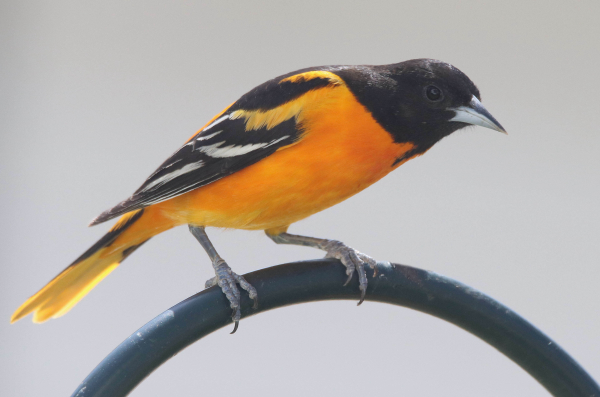
Grape Jelly has been the catalyst to attracting orioles and a variety of other birds – some among the rarest bird sightings in the region.
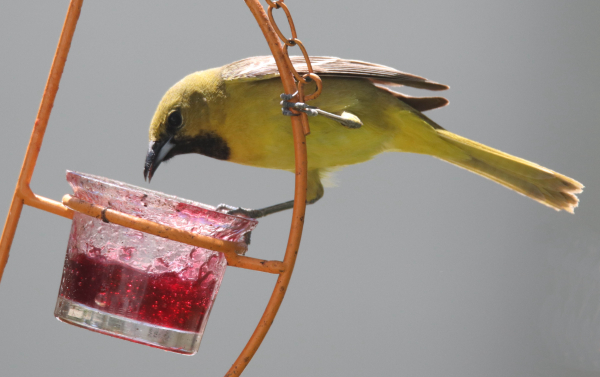
By providing grape jelly among a variety of other foods and fresh water, you create the opportunity to attract new birds to your yard this spring, perhaps a first year male Orchard Oriole.
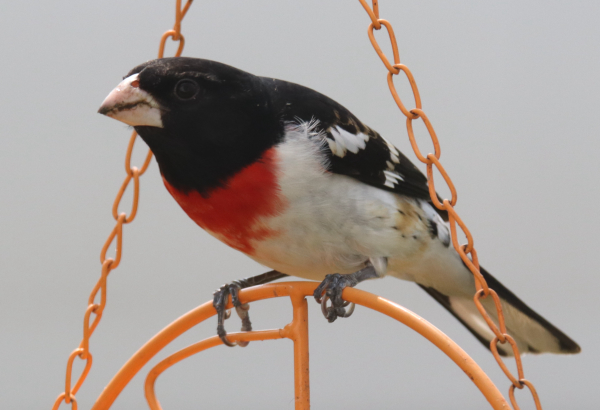
Only one male Rose-breasted Grosbeak has visited the carnival feeder, but there could be more in the near future.
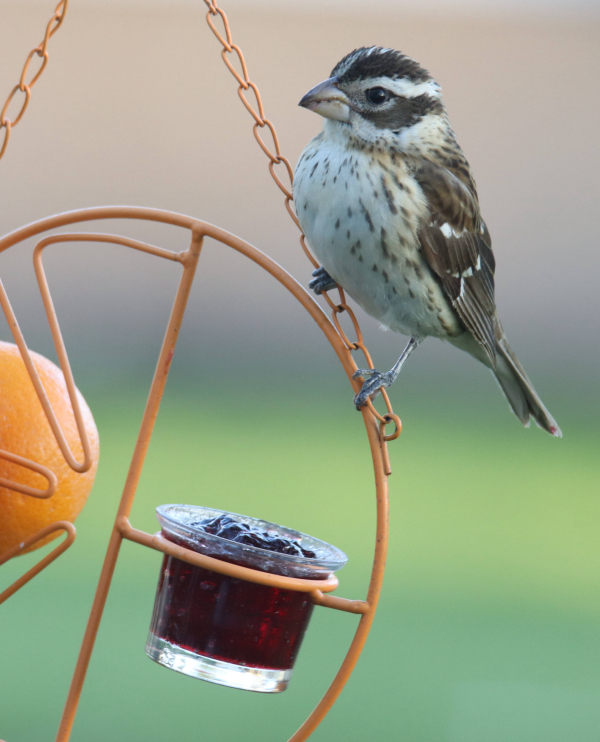
An especially pretty female Rose-breasted Grosbeak was one of a couple grape jelly females to visit.
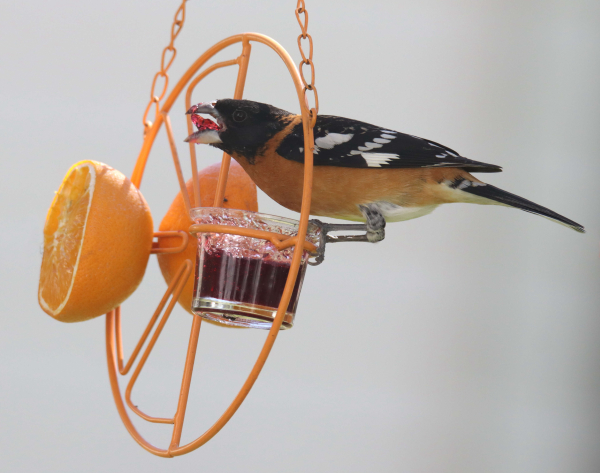
The next newbie to arrive was a male Black-headed Grosbeak, my first-in-state sighting.
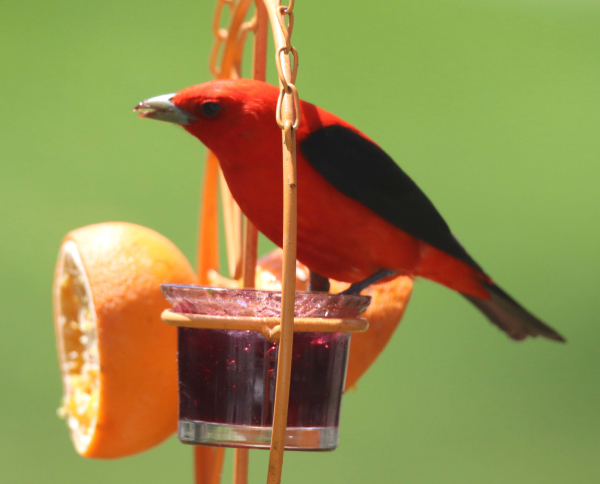
King of the carnival feeder must be the male Scarlet Tanager that suddenly appeared!
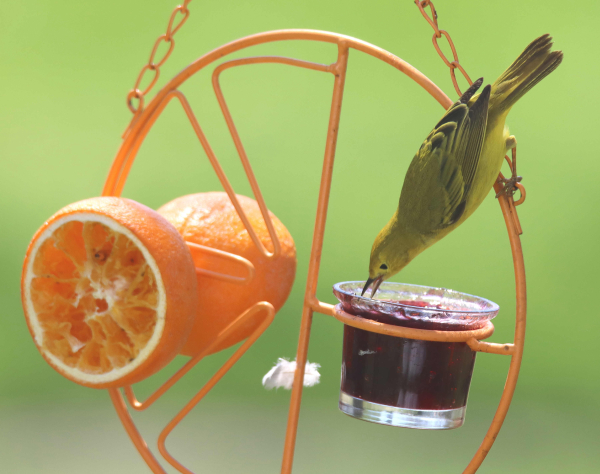
A female Yellow Warbler was also a welcome jelly fan that added a carnival flair to its feeding approach.
|
On the windiest day of spring, which was also Mother’s Day, the much anticipated first Baltimore Orioles arrived at my feeding station – Hoooray! They were all males in stunning spring plumage, as bright orange as the fragrant orange halves spiked to my carnival feeder, and as deep black as the grape jelly filling the little glass bowl. For me, it’s the biggest day of spring at my feeding station when the first orioles arrive, and I never tire of seeing them return to feed and drink fresh water throughout the day, and throughout spring and summer. But I had to wonder, what is it that attracts my attention and make these birds so special?
Perhaps it’s because it was a breakthrough to learn how to attract these colorful birds. When I first moved to this location, I would see Baltimore and Orchard Orioles from a distance a couple times each spring, during migration. But even when I cut oranges in half and placed them in my yard near where I observed an oriole moments before, only once did a Baltimore Oriole react by tasting some orange fruit. But then it happened! I don’t remember how I heard about grape jelly, or read about it, or who tuned me into the fact that grape jelly is an absolute magnet for orioles, but.
Since then, my feeding station and surrounding trees have been oriole central in my region of the state of North Dakota – for Baltimore Orioles and Orchard Orioles – and oh what fun I have had over the years providing grape jelly, sliced oranges, and fresh water for orioles! It all centers around an almost comical-looking oriole feeder that I bought some years ago, which I refer to as the “Carnival Feeder.” My accompanying photographs show the feeder from a variety of angles, so I won’t attempt to describe it, but you get the picture, and you may have seen this feeder at a store or in a yard. The term ‘carnival’ comes from the fact that it is brightly colored and shaped like an avian merry-go-round, and it’s fun to see the birds climb around it and turn this way and that to get reach the fruity foods.
As noted above, I really didn’t see many orioles before learning about grape jelly, but now, I attract as many as a dozen Baltimore Orioles at a time, along with a half-dozen Orchard Orioles! And that continues during the latter 3 weeks of May – it’s been a real spring migration breakthrough. But it doesn’t end there. Having found a dependable source of grape jelly, oranges, and water at my feeding station, along with abundant insects in the surrounding area, and mature trees that provide food, cover, and nesting sites, some of the orioles stay throughout late spring and much of the summer. What a change! And it’s all based on providing a continuous supply of grape jelly.
Of course, with that many orioles on hand during the peak of spring’s oriole invasion, I need to expand beyond the carnival feeder and it’s relatively small jelly bowl. As oriole numbers increase, I add a small bowl that I fill with jelly, and eventually a larger bowl, along with a second oriole feeder that resembles an orange hummingbird feeder that has 4 shallow jelly ports, 1 spike for a sliced orange half, and a sugar-water nectar container that has larger holes in the feeding ports so orioles can fit their bill and tongues inside (hummingbird feeding ports are too small for orioles to reach the nectar). But it’s extremely rare when I ever see an oriole taste the nectar, and I don’t need to replace many sliced oranges either, except early in the “oriole season.” Essentially, the orioles I attract are grape jelly enthusiasts, a sweet treat after feeding on a variety of bugs and caterpillars.
More Carnival Birds & Rare Visitors
Back to my carnival feeder, the birds that visit the bright orange wire feeder are not limited to Baltimore and Orchard Orioles. There are a few other birds that partake in grape jelly – American Robins, Gray Catbirds, House Finches, and a few springs ago, a male Yellow Warbler was a regular migration visitor for a few days when it was lured back to get repeated tastes of grape jelly. And every once in a while – well, very rarely really, a very rare bird comes along to surprise me in a big way when I look up from my editorial duties or leisure time.
Last year it was grosbeaks, first a male Rose-breasted Grosbeak that checked out my feeding station, then tried the grape jelly – the first male to visit my feeding station, or my yard that I know of. And when I recovered from that exciting visit, a couple days later a female Rose-breasted Grosbeak visited for grape jelly too. I’ve had female or young Rose-breasted Grosbeaks feed at my seed feeders occasionally during fall migration, but it was exciting to have a couple females check out the jelly too.
About the time I recovered from the surprise Rose-breasted Grosbeaks’ visits, another grosbeak arrived – a male Black-headed Grosbeak! And this bird represented my first sighting of the species in my yard, or anywhere in North Dakota, although they do range into West Dakota. Luckily I had opportunities to document my rare sightings with photographs of the birds on or near the carnival feeder. And I would encourage everyone to photograph birds that visit your feeders, especially rarer species.
But that’s not all, my most exciting feeder visitor to date was a male Scarlet Tanager that unceremoniously landed on the carnival feeder and began eating grape jelly! I truly couldn’t believe what I was seeing at first! This was the only Scarlet Tanager to visit my yard, although I witnessed one at Melody’s Grove some years ago, which makes only 2 sightings of these marvelous birds in the state for me.
With the excitement of these rare carnival feeder sightings refreshed in my mind, I’m hoping for more exceptional rare sightings this spring – it could happen! My carnival feeder is freshly cleaned and stocked with fresh grape jelly – what more can any bird hope for (ha-ha)? Of course, this article is not meant to be a simple reflection on my feeder and its contents, but to provide an example of what a simple thing like providing a different food at your feeding station can do – provide the right foods and water, and within reason you should attract the birds you enjoy seeing and benefitting during spring migration, through the nesting season, and year-round. And you might even attract a few surprises.
Now I’m waiting for the first Ruby-throated Hummingbirds of spring to arrive. A simple hummingbird feeder can attract an avian surprise too. The second to last hummingbird to visit my nectar feeder last fall was a male Calliope Hummingbird – only the fourth of its species recorded in the state! That said, I hope you have a rewarding spring season in your yard, at your feeding station, and anytime you venture into the field in search of new birds and new adventures in the natural world – Good Luck!
Article and Photos by Paul Konrad
Share your backyard birding experiences and photographs with The Birding Wire at editorstbw2@gmail.com